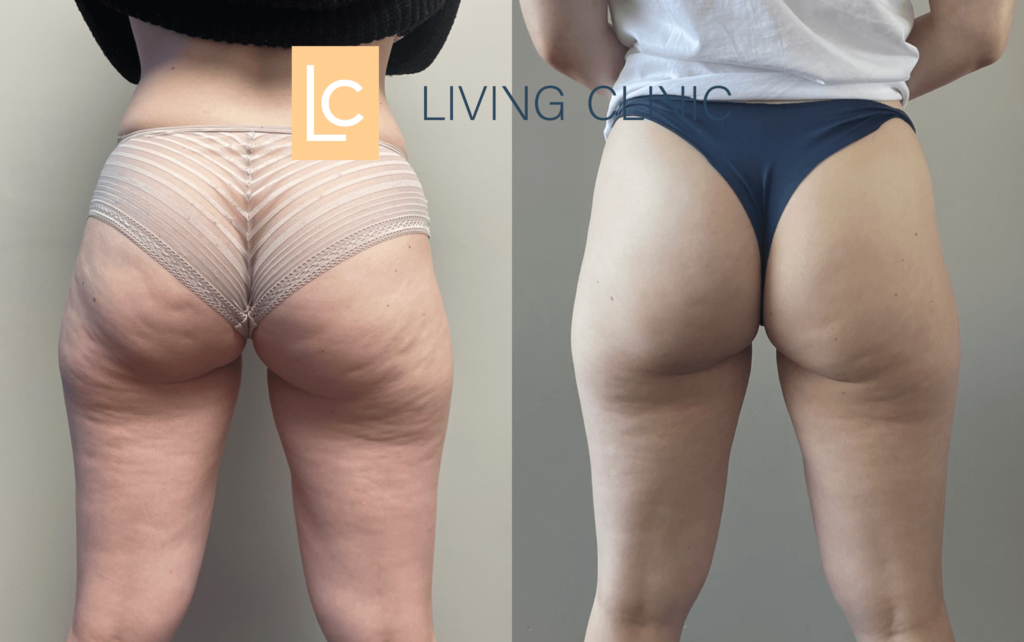How does cellulite form? (Causes)
Cellulite, also known as gynoid lipodystrophy, is characterized by changes in the appearance of the skin, generally in the areas of the buttocks, thighs, abdomen and arms. It manifests itself as an irregular texture, with an orange peel appearance, due to the accumulation of fat, liquids and toxins in fat cells.
Cellulite can be caused by a combination of factors, including genetic predisposition, hormonal changes, sedentary lifestyle, aging, blood and lymphatic circulation, among other factors.
It is important to note that cellulite is a common condition that affects many people, regardless of their weight or body shape. It does not necessarily represent a health problem, but it can be an aesthetic concern for some people.
The structure of the skin and the underlying connective tissue play an important role in the formation of cellulite. The skin has multiple layers of fat and collagen fibers that connect the skin to the underlying muscles. In cellulite-prone areas, these collagen fibers can become more rigid and less flexible, which can result in uneven skin appearance.
The accumulation of fat in the superficial layers of the skin is also a key factor in the formation of cellulite. When fat cells increase in size and are “pushed” against collagen fibers, this can create visible bulges on the surface of the skin.
However, as mentioned, genetic factors, hormonal changes, age, lifestyle and inadequate blood circulation can strongly contribute to the appearance of cellulite.
Cellulite Stages
There are different cellulite stages and types which can vary in terms of severity and appearance.
The main stages of cellulite are:
Stage 1 cellulite
Cellulite is not very visible, even when the skin is tightened. There may be a slight orange peel texture, but no significant depressions or bumps.
Stage 2 cellulite
Cellulite becomes more visible and there may be lumps and depressions in the skin when you press or contract the muscles in the affected area.
Stage 3 cellulite
Cellulite is more evident and can develop sagging skin. The bulges and depressions are more pronounced and can be seen even without pressing the skin.
Stage 4 cellulite
This is the most advanced stage of cellulite, characterized by deep and visible bulges and depressions, even when the person is at rest. The skin may appear very saggy and uneven.
Types of Cellulite
In addition to the different stages, cellulite can also be classified into different types based on its appearance:
Edematous cellulitis
This type of cellulite is associated with fluid retention and swelling. It can cause a feeling of heaviness in the legs and swollen ankles.
Fibrous Cellulite
Fibrous cellulite is characterized by harder lumps and nodules on the skin. It can be more difficult to treat due to the presence of fibrous tissue.
Flaccid cellulite
This type of cellulite usually occurs in older people and is characterized by sagging, wrinkled skin.
Mixed cellulite
Most people with cellulite have a combination of types, and mixed cellulite can have characteristics of different types, such as edematous, fibrous, or sagging.
We should not confuse “ordinary” cellulite with infectious cellulite or bacterial cellulite. This type of cellulite can cause serious complications and must be properly diagnosed and treated.
The cellulite we refer to on this page is “aesthetic cellulite” (which affects the vast majority of women and some men) and not the medical condition.
Cellulite in men: so why does cellulite tend to appear more in women?
The difference in the prevalence of cellulite between men and women is related to several physiological and hormonal reasons, in addition to differences in the structure of adipose tissue and fat distribution.
Fat distribution
Men and women have different patterns of fat distribution in their bodies. Women tend to store more fat on their thighs, hips and buttocks, while men tend to store fat more evenly throughout the body. This distribution of fat in women creates an environment conducive to the development of cellulite, as the areas where it is most common have a greater concentration of subcutaneous fat.
Connective tissue structure
The structure of the connective tissue under the skin is different in men and women. In women, the collagen fibers that connect the skin to muscles are oriented vertically, which can allow fat cells to bulge more easily and cause visible bulges on the surface of the skin. In men, these collagen fibers are generally arranged more diagonally, which makes it more difficult for cellulite to develop.
Hormones
Hormones play a crucial role in the formation of cellulite. Women have higher levels of estrogen, a hormone that affects fat metabolism and can increase the tendency for fat to accumulate in cellulite-prone areas. Additionally, hormonal fluctuations throughout a woman’s life, such as puberty, pregnancy and menopause, can influence the development of cellulite.
Cellulitis during pregnancy
The appearance of cellulite during pregnancy is a common concern for many women, but it is important to understand that it is a natural phenomenon and that there are several ways to manage and minimize its effects.
During pregnancy, several changes occur in a woman’s body that can increase the likelihood of developing cellulite:
- Weight Gain: Weight gain is a normal part of pregnancy to accommodate the baby’s growth, but increased body fat can contribute to the development of cellulite;
- Hormonal Changes: Hormonal fluctuations, such as increased levels of estrogen and progesterone, can affect fat metabolism and skin elasticity;
- Fluid Retention: Fluid retention is common during pregnancy, and the accumulation of fluid in affected areas can worsen cellulite;
- Changes in Blood Circulation: Increased blood flow and pressure on blood vessels can affect circulation in areas affected by cellulite.
There are several safe and effective treatment options to help minimize the appearance of cellulite and improve a woman’s self-esteem during this special time in life. Discover our Postpartum Recovery page and find out about our Non-Surgical Mommy Makeover Pack.
If stretch marks are also a concern, find out about our treatments for stretch marks.
Where can cellulite appear?
Cellulite can appear in various areas of the body, being most common on the buttocks and legs (especially the thighs). However, it can also occur in areas such as the belly, hips, arms and even the breasts.
What can make cellulite worse?
Some factors can increase the likelihood of developing cellulite, including a poor diet, excessive consumption of sugar and soft drinks, fats and salt, a sedentary lifestyle, tobacco, stress, hormonal changes, among others.
How to reduce cellulite?
If you want to reduce cellulite in the long term, there are several things you can do, including changes to your diet, increasing your water intake, applying topical products/cellulite creams, reducing tobacco use (which we highly recommend), among others. . However, you should be aware that these behaviors must be consistent and perpetuated over time to have any effect.
If you want to reduce cellulite in a short space of time, there are aesthetic treatments that can help. Discover the main treatments for cellulite in the following section.
Cellulite Treatments
Living Clinic offers innovative and very effective cellulite treatments, including:
-
EMTone
EMTone is the most advanced, non-invasive, FDA-cleared treatment that combines thermal and mechanical energy to target all factors that contribute to cellulite. It is a scientifically proven treatment that makes your skin soft and smooth, reducing puffiness and wrinkles.
-
EMSculpt NEO
Depending on the case, treatment with EMTone can be combined with EMSculpt for more improved toning.
EMSculpt NEO is the first and only non-invasive procedure in the world that combines 2 energies to simultaneously eliminate fat and promote muscle growth in a 30-minute session.
-
X-Wave Optimal
X-Wave Optimal is a shock wave (or acoustic wave) therapy commonly used to help reduce fat and treat cellulite. The acoustic waves stimulate the degradation of fat cells, creating new collagen and promoting an effect similar to a lymphatic drainage massage.
-
Collagen biostimulators with subcision
This is a minimally invasive treatment used in more acute cases of cellulite that have not responded to less invasive treatments. Collagen biostimulation with subcision is a technique that consists of combining the disruption of fibrous tissue (subcision) with the injection of filler substances, such as poly-L-lactic acid. The procedure is performed using local anesthesia.
In the end, what is the best treatment for cellulite?
The best treatment for cellulite will depend on what the doctor or specialist recommends for your particular case, depending on the type and degree of cellulite. You must schedule an evaluation appointment.
Cellulite Treatment: Before and After

Discover the complete medical case in EMTone Before and After.
Schedule a consultation to hear our professionals’ recommendations for your particular case and clarify all your doubts.
We are at Av. da Boavista, in Porto!



